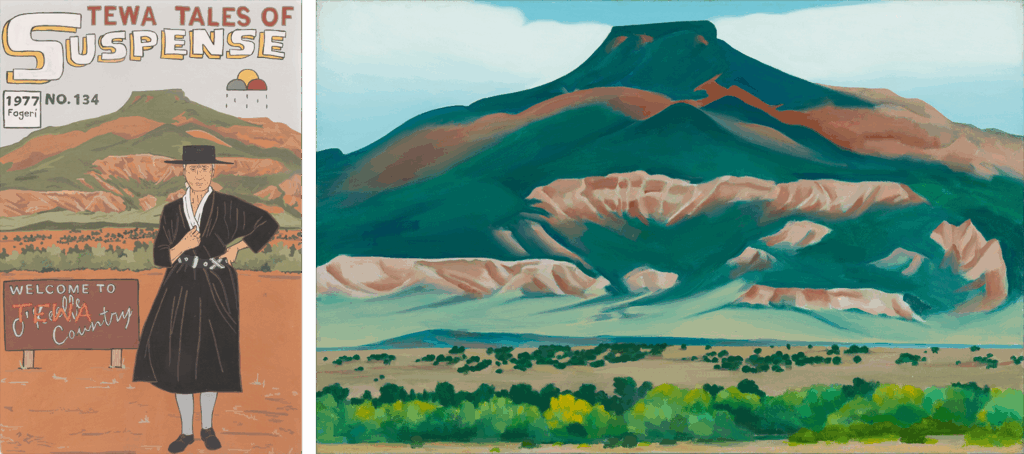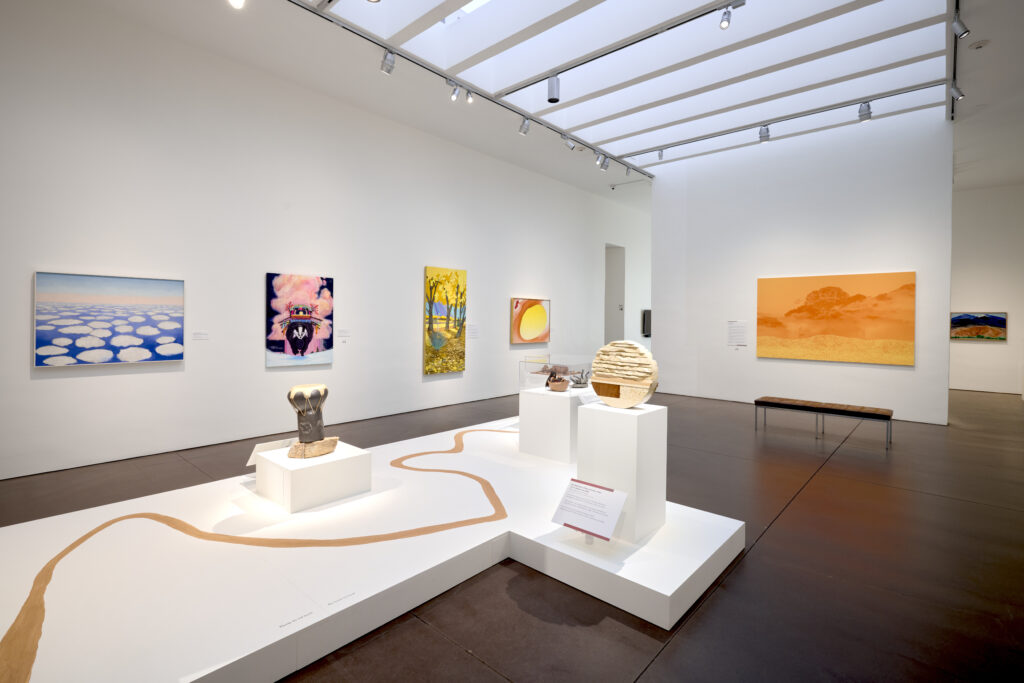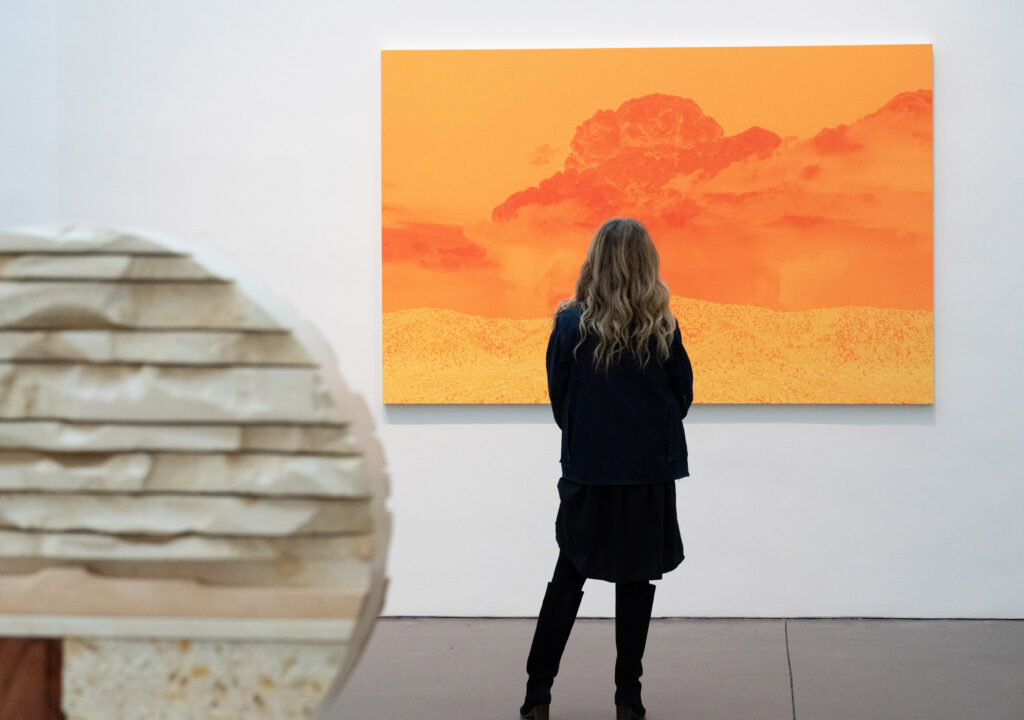Current Exhibition
Tewa Nangeh/Tewa Country
November 7, 2025 - September 7, 2026
Santa Fe, NM
Georgia O'Keeffe Museum


Tewa Nangeh/Tewa Country honors Tewa people, art, culture, and landscapes, while drawing awareness to the erasure of the Tewa presence from the story of Georgia O’Keeffe in Northern New Mexico. Co-curated by artist Jason Garcia (Santa Clara Pueblo) and Bess Murphy, Luce Curator of Art and Social Practice at the Georgia O’Keeffe Museum, the exhibition features artists, scholars, and culture bearers from the six Tewa Pueblos of Northern New Mexico: Nambé, Ohkay Owingeh, Pojoaque, San Ildefonso, Santa Clara, and Tesuque.
While Georgia O’Keeffe frequently claimed ownership of Northern New Mexico, this land has been the continuous home of these six Tewa Pueblos from time immemorial to the present. Tewa Nangeh/Tewa Country resituates the O’Keeffe narrative back in Tewa Country.
The exhibition brings O’Keeffe’s art and personal objects into dialogue with newly created artworks by contemporary Tewa artists to highlight themes of sacred spaces, belonging, identity, and ownership. Through storytelling and cultural exchange, the project will create a platform for learning about the past, present, and future of Tewa land, and the complexities of O’Keeffe’s own presence in New Mexico.
Participating Artists:
These artists have worked together for more than two years to develop and envision this exhibition:
Dr. Joseph Woody Aguilar (San Ildefonso Pueblo)
Samuel Villarreal Catanach (P’osuwäegeh Ówingeh / Pueblo of Pojoaque)
Jason Garcia/Okuu Pín (Kha’p’o Owingeh / Santa Clara Pueblo)
John Garcia Sr. (Kha’p’o Owingeh / Santa Clara Pueblo)
Charine Pilar Gonzales (San Ildefonso Pueblo)
Marita Swazo Hinds (Tesuque Pueblo)
Dr. Matthew Martinez (Ohkay Owingeh)
Arlo Namingha (Ohkay Owingeh, Hopi)
Michael Namingha (Ohkay Owingeh, Hopi)
Eliza Naranjo Morse (Kha’p’o Owingeh / Santa Clara Pueblo)
Martha Romero (Nambé Pueblo)
Randolph Silva (Kha’p’o Owingeh / Santa Clara Pueblo)
Note: The spellings of tribal affiliations have been determined by each artist and reflect the wishes of themselves, their families, and their communities. As Tewa is still primarily a spoken language, there is inherent variation in these spellings; we choose here to respect the choices of the individual artists.
Read More:
- “The Indigenous Histories That Georgia O’Keeffe Forgot” by Nancy Zastudil for Hyperallergic
- “Don’t Call it “O’Keeffe Country”: Two Pueblo Artists Take Back New Mexico’s Map” by Kimberly Suina Melwani for Southwest Contemporary
- “This Is Not Just O’Keeffe Country” by Jacob Entenman for the Henry Luce Foundation
- “New Exhibition at Georgia O’Keeffe Museum Foregrounds Contemporary Indigenous Perspectives” by Logan Royce Beitman for the Albuquerque Journal
- “Indigenous Artists Reframe the ‘Ownership’ of Ancestral Lands” by Ania Hull for Pasatiempo and the Santa Fe New Mexican
- “Pueblo Stories at O’Keeffe Museum” by Michael Abatemarco for New Mexico Magazine
- “Editor’s Picks: Southwest Contemporary’s Winter 2025-26 Art Guide” by SWC editorial director Jordan Eddy for Southwest Contemporary
- “First American Art Magazine’s Top Ten Native Art Events of 2025” by First American Art Magazine
Listen to the curators and artists discuss the exhibition on the Richard Eeds Radio Show:
- October 1 | Jason Garcia and Micael Namingha
- October 29 | Bess Murphy, Charine Pilar Gonzales, Arlo Namingha
Admission for the Georgia O’Keeffe Museum is free for members of Indigenous communities, tribes, and nations for the duration of Tewa Nangeh/Tewa Country.

Mornings with O’Keeffe: “Tewa Nangeh/Tewa Country”
Wednesday, January 7 | 9:00 AM MT
Online
Supported by:

